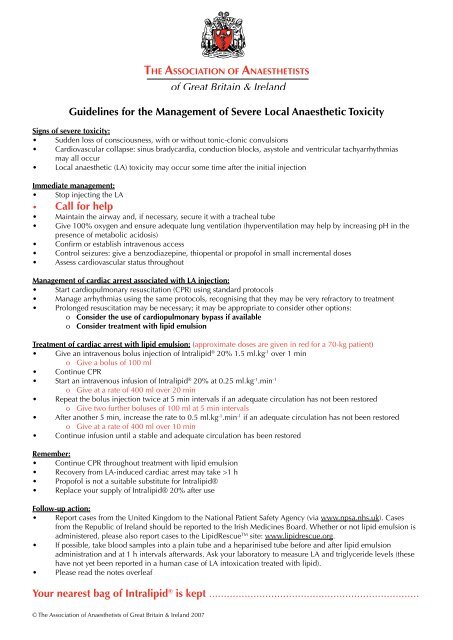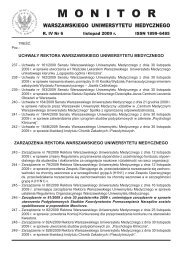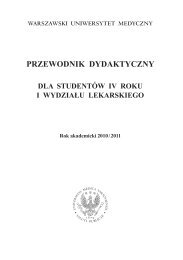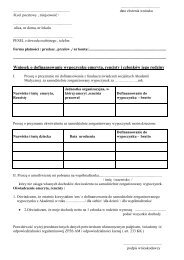Guidelines for the Management of Severe Local Anaesthetic Toxicity ...
Guidelines for the Management of Severe Local Anaesthetic Toxicity ...
Guidelines for the Management of Severe Local Anaesthetic Toxicity ...
- No tags were found...
You also want an ePaper? Increase the reach of your titles
YUMPU automatically turns print PDFs into web optimized ePapers that Google loves.
<strong>Guidelines</strong> <strong>for</strong> <strong>the</strong> <strong>Management</strong> <strong>of</strong> <strong>Severe</strong> <strong>Local</strong> Anaes<strong>the</strong>tic <strong>Toxicity</strong><br />
Signs <strong>of</strong> severe toxicity:<br />
• Sudden loss <strong>of</strong> consciousness, with or without tonic-clonic convulsions<br />
• Cardiovascular collapse: sinus bradycardia, conduction blocks, asystole and ventricular tachyarrhythmias<br />
may all occur<br />
• <strong>Local</strong> anaes<strong>the</strong>tic (LA) toxicity may occur some time after <strong>the</strong> initial injection<br />
Immediate management:<br />
• Stop injecting <strong>the</strong> LA<br />
• Call <strong>for</strong> help<br />
• Maintain <strong>the</strong> airway and, if necessary, secure it with a tracheal tube<br />
• Give 100% oxygen and ensure adequate lung ventilation (hyperventilation may help by increasing pH in <strong>the</strong><br />
presence <strong>of</strong> metabolic acidosis)<br />
• Confirm or establish intravenous access<br />
• Control seizures: give a benzodiazepine, thiopental or prop<strong>of</strong>ol in small incremental doses<br />
• Assess cardiovascular status throughout<br />
<strong>Management</strong> <strong>of</strong> cardiac arrest associated with LA injection:<br />
• Start cardiopulmonary resuscitation (CPR) using standard protocols<br />
• Manage arrhythmias using <strong>the</strong> same protocols, recognising that <strong>the</strong>y may be very refractory to treatment<br />
• Prolonged resuscitation may be necessary; it may be appropriate to consider o<strong>the</strong>r options:<br />
o Consider <strong>the</strong> use <strong>of</strong> cardiopulmonary bypass if available<br />
o Consider treatment with lipid emulsion<br />
Treatment <strong>of</strong> cardiac arrest with lipid emulsion: (approximate doses are given in red <strong>for</strong> a 70-kg patient)<br />
• Give an intravenous bolus injection <strong>of</strong> Intralipid ® 20% 1.5 ml.kg -1 over 1 min<br />
o Give a bolus <strong>of</strong> 100 ml<br />
• Continue CPR<br />
• Start an intravenous infusion <strong>of</strong> Intralipid ® 20% at 0.25 ml.kg -1 .min -1<br />
o Give at a rate <strong>of</strong> 400 ml over 20 min<br />
• Repeat <strong>the</strong> bolus injection twice at 5 min intervals if an adequate circulation has not been restored<br />
o Give two fur<strong>the</strong>r boluses <strong>of</strong> 100 ml at 5 min intervals<br />
• After ano<strong>the</strong>r 5 min, increase <strong>the</strong> rate to 0.5 ml.kg -1 .min -1 if an adequate circulation has not been restored<br />
o Give at a rate <strong>of</strong> 400 ml over 10 min<br />
• Continue infusion until a stable and adequate circulation has been restored<br />
Remember:<br />
• Continue CPR throughout treatment with lipid emulsion<br />
• Recovery from LA-induced cardiac arrest may take >1 h<br />
• Prop<strong>of</strong>ol is not a suitable substitute <strong>for</strong> Intralipid®<br />
• Replace your supply <strong>of</strong> Intralipid® 20% after use<br />
Follow-up action:<br />
• Report cases from <strong>the</strong> United Kingdom to <strong>the</strong> National Patient Safety Agency (via www.npsa.nhs.uk). Cases<br />
from <strong>the</strong> Republic <strong>of</strong> Ireland should be reported to <strong>the</strong> Irish Medicines Board. Whe<strong>the</strong>r or not lipid emulsion is<br />
administered, please also report cases to <strong>the</strong> LipidRescue TM site: www.lipidrescue.org.<br />
• If possible, take blood samples into a plain tube and a heparinised tube be<strong>for</strong>e and after lipid emulsion<br />
administration and at 1 h intervals afterwards. Ask your laboratory to measure LA and triglyceride levels (<strong>the</strong>se<br />
have not yet been reported in a human case <strong>of</strong> LA intoxication treated with lipid).<br />
• Please read <strong>the</strong> notes overleaf<br />
Your nearest bag <strong>of</strong> Intralipid ® is kept .......................................................................<br />
© The Association <strong>of</strong> Anaes<strong>the</strong>tists <strong>of</strong> Great Britain & Ireland 2007
Notes<br />
• Intralipid® 20% has been shown to reverse LA-induced cardiac arrest in animal models [1,2] and in human<br />
case reports [3,4], and its use has been reported in <strong>the</strong> treatment <strong>of</strong> life-threatening toxicity without cardiac<br />
arrest [5]. Its <strong>the</strong>rapeutic potential has been highlighted by <strong>the</strong> National Patient Safety Agency [6].<br />
• Intralipid® 20% 1000 ml should be immediately available in all areas where potentially cardiotoxic doses <strong>of</strong><br />
local anaes<strong>the</strong>tics are given, along with guidelines <strong>for</strong> its use.<br />
• In <strong>the</strong> UK, Intralipid® is distributed by Fresenius Kabi Ltd. It is distributed in <strong>the</strong> Republic <strong>of</strong> Ireland by Cahill<br />
May Roberts.<br />
• Intralipid® is readily available from most hospital pharmacies, which may also be able to help departments with<br />
timely replacement <strong>of</strong> bags nearing expiry.<br />
• The usefulness <strong>of</strong> o<strong>the</strong>r lipid emulsions is not known, as published work to date has only used Intralipid®.<br />
• Although some prop<strong>of</strong>ol preparations are provided in Intralipid®, e.g. Diprivan®, <strong>the</strong>se are not a suitable<br />
alternative, due to <strong>the</strong> significant cardiovascular depression caused by <strong>the</strong> prop<strong>of</strong>ol. This does not preclude <strong>the</strong><br />
use <strong>of</strong> small, incremental doses <strong>of</strong> prop<strong>of</strong>ol to control seizures.<br />
• The use <strong>of</strong> Intralipid® in this way is relatively novel. There<strong>for</strong>e, future laboratory and clinical experiences are<br />
likely to dictate fur<strong>the</strong>r refinement <strong>of</strong> <strong>the</strong> method.<br />
• This guideline document will be reviewed regularly and updated when necessary. Updated versions will be<br />
available on http://www.aagbi.org and http://www.lipidrescue.org.<br />
• Fur<strong>the</strong>r educational matter is available at http://www.lipidrescue.org.<br />
References<br />
1. Weinberg G et al. Lipid emulsion infusion rescues dogs from bupivacaine-induced cardiac toxicity. Regional<br />
Anes<strong>the</strong>sia and Pain Medicine 2003; 28: 198-202<br />
2. Weinberg GL et al. Pretreatment or resuscitation with a lipid infusion shifts <strong>the</strong> dose-response to bupivacaineinduced<br />
asystole in rats. Anes<strong>the</strong>siology 1998; 88: 1071-5<br />
3. Rosenblatt MA et al. Successful use <strong>of</strong> a 20% Lipid emulsion to resuscitate a patient after a presumed<br />
bupivacaine-related cardiac arrest. Anes<strong>the</strong>siology 2006; 105: 217-8<br />
4. Litz RJ et al. Successful resuscitation <strong>of</strong> a patient with ropivacaine-induced asystole after axillary plexus block<br />
using lipid infusion. Anaes<strong>the</strong>sia 2006; 61: 800-1<br />
5. Foxall G et al. Levobupivacaine-induced seizures and cardiovascular collapse treated with Intralipid.<br />
Anaes<strong>the</strong>sia 2007; 62: 516-8.<br />
6. Patient Safety Alert 21 (28 March 2007) – Safer practice with epidural injections and infusions. London:<br />
National Patient Safety Agency (www.npsa.nhs.uk)<br />
This guideline is not a standard <strong>of</strong> medical care. The ultimate judgement with regard to a particular clinical procedure<br />
or treatment plan must be made by <strong>the</strong> clinician in <strong>the</strong> light <strong>of</strong> <strong>the</strong> clinical data presented and <strong>the</strong> diagnostic and<br />
treatment options available.<br />
© The Association <strong>of</strong> Anaes<strong>the</strong>tists <strong>of</strong> Great Britain & Ireland 2007
















